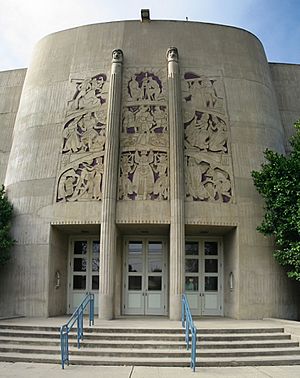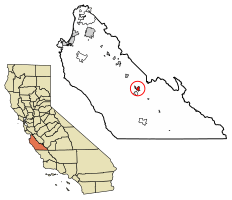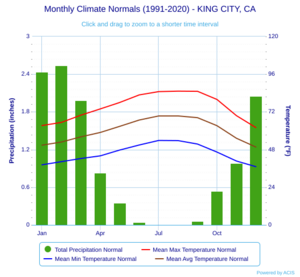King City, California facts for kids
Quick facts for kids
King City, California
|
|
|---|---|

The Robert Stanton Theater at King City High School (1939)
|
|

Location in Monterey County, California
|
|
| Country | United States |
| State | California |
| County | Monterey |
| Railway stop | 1886 |
| Incorporated | February 9, 1911 |
| Named for | Charles King |
| Area | |
| • Total | 3.93 sq mi (10.2 km2) |
| • Land | 3.80 sq mi (9.8 km2) |
| • Water | 0.13 sq mi (0.3 km2) 3.36% |
| Elevation | 335 ft (102 m) |
| Population
(2020)
|
|
| • Total | 13,332 |
| • Density | 3,508.4/sq mi (1,354.6/km2) |
| Time zone | UTC−8 (Pacific) |
| • Summer (DST) | UTC−7 (PDT) |
| ZIP code |
93930
|
| Area code | 831 |
| FIPS code | 06-38520 |
| GNIS feature IDs | 1652734, 2411544 |
King City is a town in Monterey County, California, United States. It's located along the Salinas River, about 51 miles (82 km) southeast of Salinas. The town is also found along U.S. Route 101 in the Salinas Valley, which is part of California's Central Coast. King City is part of the Association of Monterey Bay Area Governments. In 2020, about 13,332 people lived there.
Contents
History of King City
Early Explorations and Settlements
The first European explorers came to this area in 1769. Don Gaspar de Portolá's Spanish group camped near where King City is today. This was on September 26, 1769, by the Salinas River.
The Dutton Hotel, Stagecoach Station was an important stop in King City. It was an old adobe inn that started in 1849. This hotel was a major stop for stagecoaches on El Camino Real in the late 1880s. It is now a historic landmark.
How King City Got Its Name
King City was first called "Kings City" after its founder, Charles King. In 1884, Charles King bought a large piece of land, about 13,000 acres (53 sq km). This land was originally part of a Mexican land grant. King started growing a lot of wheat, about 6,000 acres (24 sq km) of it.
To help get his crops to market, King allowed the Southern Pacific Railroad to build tracks across his land. The end of the railway line was called "King's" station.
In 1886, the Southern Pacific Railroad finished building its line to King City station. This helped farms and ranches in the south Salinas Valley send their goods to big cities like San Francisco and Los Angeles.
The town was once jokingly called "Hog Town" because many semi-wild hogs roamed the fields. Charles King wanted to name the town "Vanderhurst" after a local merchant, William Vanderhurst. But the people voted against it and named it after him instead. The town was known as Kings', then the City of King, and finally King City.
The first post office in King City opened in 1887. King City officially became a city in 1911.
Important People and Agriculture
J. Ernst Steinbeck, who was the father of famous writer John Steinbeck, said he was the first person to live permanently in King City. He was one of the first settlers and worked for the Southern Pacific Milling Company. This company built an early warehouse and flour mill by the railroad tracks.
Farming has always been a big part of King City's history. Between 1910 and 1930, the city became well-known for growing pink beans. These "King City Pinks" were sold all over the country, especially during World War I when there was extra demand.
Historic Buildings
The Robert Stanton Auditorium was built in 1939. It was a project during the Great Depression. This building is a great example of the Art Moderne style. It has cool rounded corners, tall columns, and a wide curved staircase. Inside and out, you can see art by Jo Mora, which shows important historical scenes. In 1991, it was added to the National Register of Historic Places.
Geography of King City
King City is located in the southeastern part of Monterey County in the Salinas Valley. It sits about 330 feet (101 meters) above sea level. The town is between Greenfield (13 miles or 21 km northwest) and San Lucas (9 miles or 14 km southeast). All these towns are along U.S. Route 101.
King City covers about 3.8 square miles (9.8 sq km) of land. A small part, about 0.1 square miles (0.26 sq km), is water. The Salinas River flows on the west side of the city. Sometimes, especially in summer, parts of the river flow underground because its bed is sandy.
Climate in King City
King City has a semi-arid climate, which means it's quite dry. It's also close to a Mediterranean climate. Summers are very warm and mostly dry, while winters are cool and wet.
In January, the average high temperature is about 64.1°F (17.8°C), and the average low is 34.9°F (1.6°C). In July, the average high is 86.9°F (30.5°C), and the average low is 51.0°F (10.6°C).
The city has about 50 days a year where the temperature reaches 90°F (32°C) or higher. It also has about 50 days where the temperature drops to 32°F (0°C) or lower. The hottest temperature ever recorded was 116°F (47°C) in September 2022. The coldest was 14°F (-10°C) in December 1990.
King City gets about 11.24 inches (285 mm) of rain each year. It rains on about 40 days. Snow is very rare in the Salinas Valley, but it did snow 5.3 inches (13 cm) in January 1957 and 3.0 inches (7.6 cm) in December 1954. The air in King City is often dry, which means it can get very cold at night and very hot during the day.
| Climate data for King City, California (1991–2020 normals, extremes 1926–present) | |||||||||||||
|---|---|---|---|---|---|---|---|---|---|---|---|---|---|
| Month | Jan | Feb | Mar | Apr | May | Jun | Jul | Aug | Sep | Oct | Nov | Dec | Year |
| Record high °F (°C) | 86 (30) |
90 (32) |
93 (34) |
104 (40) |
108 (42) |
112 (44) |
111 (44) |
113 (45) |
116 (47) |
109 (43) |
95 (35) |
91 (33) |
115 (46) |
| Mean maximum °F (°C) | 75.4 (24.1) |
78.7 (25.9) |
84.4 (29.1) |
91.7 (33.2) |
94.6 (34.8) |
100.2 (37.9) |
98.6 (37.0) |
99.9 (37.7) |
101.9 (38.8) |
96.3 (35.7) |
84.8 (29.3) |
73.2 (22.9) |
105.3 (40.7) |
| Mean daily maximum °F (°C) | 63.3 (17.4) |
65.3 (18.5) |
69.9 (21.1) |
73.9 (23.3) |
78.0 (25.6) |
82.8 (28.2) |
84.9 (29.4) |
85.2 (29.6) |
85.1 (29.5) |
79.9 (26.6) |
69.6 (20.9) |
62.0 (16.7) |
75.0 (23.9) |
| Daily mean °F (°C) | 50.8 (10.4) |
52.8 (11.6) |
56.1 (13.4) |
58.9 (14.9) |
62.8 (17.1) |
66.8 (19.3) |
69.4 (20.8) |
69.4 (20.8) |
68.3 (20.2) |
63.2 (17.3) |
55.2 (12.9) |
49.6 (9.8) |
60.3 (15.7) |
| Mean daily minimum °F (°C) | 38.3 (3.5) |
40.3 (4.6) |
42.3 (5.7) |
44.0 (6.7) |
47.7 (8.7) |
50.9 (10.5) |
53.8 (12.1) |
53.7 (12.1) |
51.5 (10.8) |
46.4 (8.0) |
40.7 (4.8) |
37.1 (2.8) |
45.6 (7.6) |
| Mean minimum °F (°C) | 27.4 (−2.6) |
29.8 (−1.2) |
32.7 (0.4) |
35.4 (1.9) |
40.0 (4.4) |
43.7 (6.5) |
47.6 (8.7) |
48.0 (8.9) |
43.7 (6.5) |
36.3 (2.4) |
29.6 (−1.3) |
25.9 (−3.4) |
24.0 (−4.4) |
| Record low °F (°C) | 15 (−9) |
19 (−7) |
22 (−6) |
24 (−4) |
31 (−1) |
36 (2) |
34 (1) |
31 (−1) |
32 (0) |
23 (−5) |
20 (−7) |
14 (−10) |
14 (−10) |
| Average precipitation inches (mm) | 2.44 (62) |
2.54 (65) |
1.98 (50) |
0.83 (21) |
0.35 (8.9) |
0.04 (1.0) |
0.01 (0.25) |
0.01 (0.25) |
0.06 (1.5) |
0.54 (14) |
0.98 (25) |
2.05 (52) |
11.83 (300) |
| Average precipitation days (≥ 0.01 in) | 8.8 | 9.2 | 7.8 | 5.2 | 2.6 | 0.5 | 0.3 | 0.2 | 0.6 | 2.4 | 4.6 | 8.7 | 50.9 |
| Source: NOAA | |||||||||||||
Getting Around King City
Bus services in King City are provided by Monterey-Salinas Transit.
- Line 34 is a local bus that goes around King City.
- Line 23 connects King City to other towns in the Salinas Valley.
- Line 84 offers service to Paso Robles and towns further south.
King City is also served by Amtrak Thruway buses. Passenger trains pass through, but they don't stop in King City. The city wants to build a transportation center to connect with Amtrak trains in the future.
People of King City
| Historical population | |||
|---|---|---|---|
| Census | Pop. | %± | |
| 1890 | 253 | — | |
| 1920 | 1,048 | — | |
| 1930 | 1,483 | 41.5% | |
| 1940 | 1,768 | 19.2% | |
| 1950 | 2,347 | 32.7% | |
| 1960 | 2,937 | 25.1% | |
| 1970 | 3,717 | 26.6% | |
| 1980 | 5,495 | 47.8% | |
| 1990 | 7,634 | 38.9% | |
| 2000 | 11,094 | 45.3% | |
| 2010 | 12,874 | 16.0% | |
| 2020 | 13,332 | 3.6% | |
Population in 2020
In 2020, King City had a population of 13,332 people. Most of the people living in King City are of Hispanic or Latino background, making up about 89.5% of the population.
Population in 2010
In 2010, King City had 12,874 people. About 87.5% of the people were Hispanic or Latino.
- There were 3,008 households.
- Many households (61.6%) had children under 18.
- The average household had 4.26 people.
- The median age was 25.9 years old. This means half the people were younger than 25.9, and half were older.
Population in 2000
In 2000, there were 11,094 people in King City.
- About 80.4% of the population was Hispanic or Latino.
- The average household had 4.03 people.
- The median age was 25 years.
- The average income for a household was $34,398 per year.
Media in King City
Radio and Television
You can listen to local radio stations like KEXA-FM (93.9), KRKC-AM (1490), KRKC-FM (102.5), and KDON-FM (102.5). Television service comes from the Monterey–Salinas–Santa Cruz area.
Newspapers
Local newspapers include the Salinas Californian and the town's own weekly paper, The King City Rustler.
The King City Rustler started in 1901. Its founder, Fred Vivian, reportedly asked people in a barber shop to suggest names for the newspaper. He picked "The Rustler."
Fred Vivian's grandson, Harry Casey, later took over the newspaper in 1952. He ran it until 1995 when he sold it. Both Harry Casey and Fred Vivian are honored in the California Newspaper Hall of Fame.
Notable People from King City
- Eldon Dedini, a famous cartoonist.
- Jim Mankins (1944-2004), a football player from King City High School who played for Oklahoma and Florida State.
- George Taylor Morris (1947–2009), a radio host.
See also
 In Spanish: King City (California) para niños
In Spanish: King City (California) para niños



